R&D: Electric Skyrmions Charge Ahead for Next-Gen Storage From Berkeley Lab
Research team makes chiral skyrmion crystal with electric properties, puts new spin on future information storage applications.
This is a Press Release edited by StorageNewsletter.com on May 17, 2019 at 2:04 pmBerkeley Lab-led research team makes a chiral skyrmion crystal with electric properties; puts new spin on future information storage applications.
Video: Simulation of a single polar skyrmion. Red arrows signify that this is a left-handed skyrmion. The other arrows represent the angular distribution of the dipoles.
(Credit: Xiaoxing Cheng, Pennsylvania State University; C.T. Nelson, Oak Ridge National Laboratory; and Ramamoorthy Ramesh, Berkeley Lab)
When you toss a ball, what hand do you use? Left-handed people naturally throw with their left hand, and right-handed people with their right. This natural preference for one side versus the other is called handedness, and can be seen almost everywhere – from a glucose molecule whose atomic structure leans left, to a dog who shakes ‘hands’ only with her right.
Handedness can be exhibited in chirality – where two objects, like a pair of gloves, can be mirror images of each other but cannot be superimposed on one another. Now a team of researchers led by Berkeley Lab has observed chirality for the first time in polar skyrmions – quasiparticles akin to tiny magnetic swirls – in a material with reversible electrical properties. The combination of polar skyrmions and these electrical properties could one day lead to applications such as more powerful data storage devices that continue to hold information – even after a device has been powered off. Their findings were reported this week in the journal Nature.
“What we discovered is just mind-boggling,” said Ramamoorthy Ramesh, who holds appointments as a faculty senior scientist in Berkeley Lab’s Materials Sciences Division and as the Purnendu Chatterjee Endowed chair in Energy Technologies in Materials Science and Engineering and Physics at UC Berkeley. “We hadn’t planned on making skyrmions. So for us to end up making a chiral skyrmion is exciting.”
STEM images of a strontium titanate/lead titanate superlattice.
(Credit: Berkeley Lab)
When the team of researchers – co-led by Ramesh and Lane Martin, a staff scientist in Berkeley Lab’s Materials Sciences Division and a professor in Materials Science and Engineering at UC Berkeley – began this study in 2016, they had set out to find ways to control how heat moves through materials. So they fabricated a special crystal structure called a superlattice from alternating layers of lead titanate (an electrically polar material, whereby one end is positively charged and the opposite end is negatively charged) and strontium titanate (an insulator, or a material that doesn’t conduct electric current).
But once they took STEM (scanning transmission electron microscopy) measurements of the lead titanate/strontium titanate superlattice at the Molecular Foundry, a U.S. DOE Office of Science User Facility at Berkeley Lab that specializes in nanoscale science, they saw something strange that had nothing to do with heat: Bubble-like formations had cropped up all across the device.
Bubbles, bubbles everywhere
So what were these ‘bubbles,’ and how did they get there?
Those bubbles, it turns out, were polar skyrmions – or textures made up of opposite electric charges known as dipoles. Researchers had always assumed that skyrmions would only appear in magnetic materials, where special interactions between magnetic spins of charged electrons stabilize the twisting chiral patterns of skyrmions. So when the Berkeley Lab-led team of researchers discovered skyrmions in an electric material, they were astounded.
Simulation of the cross-section in the middle of the polar-skyrmion bubble.
(Credit: Berkeley Lab)
Through the researchers’ collaboration with theorists Javier Junquera, University of Cantabria in Spain, and Jorge Íñiguez, Luxembourg Institute of Science and Technology, they discovered that these textures had a unique feature called a ‘Bloch component’ that determined the direction of its spin, which Ramesh compares to the fastening of a belt – where if you’re left-handed, the belt goes from left to right. “And it turned out that this Bloch component – the skyrmion’s equatorial belt, so to speak – is the key to its chirality or handedness,” he said.
While using sophisticated STEM at Berkeley Lab’s Molecular Foundry and at the Cornell Center for Materials Research, where David Muller, Cornell University took atomic snapshots of skyrmions’ chirality at room temperature in real time, the researchers discovered that the forces placed on the polar lead titanate layer by the nonpolar strontium titanate layer generated the polar skyrmion ‘bubbles’ in the lead titanate.
“Materials are like people,” said Ramesh. “When people get stressed, they respond in unpredictable ways. And that’s what materials do too: In this case, by surrounding lead titanate by strontium titanate, lead titanate starts to go crazy – and one way that it goes crazy is to create polar textures like skyrmions.”
Shining a light on crystal chirality
To confirm their observations, senior staff scientist Elke Arenholz and staff scientist Padraic Shafer at Berkeley Lab’s Advanced Light Source (ALS), along with Margaret McCarter, a physics Ph.D. student from the Ramesh Lab at UC Berkeley, probed the chirality by using a spectroscopic technique known as RSXD-CD (resonant soft X-ray diffraction circular dichroism), one of the highly optimized tools available to the scientific community at the ALS, a U.S. DOE Office of Science User Facility that specializes in lower energy, ‘soft’ X-ray light for studying the properties of materials.
Simulations of skyrmion bubbles and elongated skyrmions
for the lead titanate/strontium titanate superlattice.
(Credit: Berkeley Lab)
Light waves can be ‘circularly polarized’ to also have handedness, so the researchers theorized that if polar skyrmions have handedness, a left-handed skyrmion, for example, should interact more strongly with left-handed, circularly polarized light – an effect known as circular dichroism.
When McCarter and Shafer tested the samples at the ALS, they successfully uncovered another piece to the chiral skyrmion puzzle – they found that incoming circularly polarized X-rays, like a screw whose threads rotate either clockwise or counterclockwise, interact with skyrmions whose dipoles rotate in the same direction, even at room temperature. In other words, they found evidence of circular dichroism – where there is only a strong interaction between X-rays and polar skyrmions with the same handedness.
“The theoretical simulations and microscopy both revealed the presence of a Bloch component, but to confirm the chiral nature of these skyrmions, the last piece of the puzzle was really the circular dichroism measurements,” McCarter said. “It is amazing to observe this effect in materials that typically don’t have handedness. We are excited to explore the implications of this chirality in a ferroelectric and how it can be controlled in a way that could be useful for storing data.”
Now that the researchers have made a single electric skyrmion and confirmed its chirality, they plan to make an array of dozens of electric skyrmions – each one with a diameter of just 8nm (for comparison, the Ebola virus is about 50nm wide) – with the same handedness. “In terms of applications, this is exciting because now we have chirality – switching a skyrmion on or off, or between left-handed and right-handed – on top of still being able to use the charge for storing data,” Ramesh said.
The researchers next plan to study the effects of applying an electric field on the polar skyrmions. “Now that we know that polar/electric skyrmions are chiral, we want to see if we can electrically manipulate them. If I apply an electric field, can I turn each one like a turnstile? Can I move each one, one at a time, like a checker on a checkerboard? If we can somehow move them, write them, and erase them for data storage, then that would be an amazing new technology,” Ramesh said.
Also contributing to the study were researchers from Pennsylvania State University, Cornell University, and Oak Ridge National Laboratory.
The work was supported by the DOE Office of Science with additional funding provided by the Gordon and Betty Moore Foundation’s EPiQS Initiative, the National Science Foundation, the Luxembourg National Research Fund, and the Spanish Ministry of Economy and Competitiveness.
Article: Observation of room-temperature polar skyrmions
Nature has published an article written by S. Das, Y. L. Tang, Department of Materials Science and Engineering, University of California, Berkeley, CA, USA, Z. Hong, Department of Materials Science and Engineering, The Pennsylvania State University, University Park, PA, USA, M. A. P. Gonçalves, Materials Research and Technology Department, Luxembourg Institute of Science and Technology (LIST), Esch/Alzette, Luxembourg, M. R. McCarter, Department of Physics, University of California, Berkeley, CA, USA, C. Klewe, Advanced Light Source, Lawrence Berkeley National Laboratory, Berkeley, CA, USA, K. X. Nguyen, Department of Chemistry and Chemical Biology, Cornell University, Ithaca, NY, USA, F. Gómez-Ortiz, Departamento de Ciencias de la Tierra y Física de la Materia Condensada, Universidad de Cantabria, Santander, Spain, P. Shafer, Advanced Light Source, Lawrence Berkeley National Laboratory, Berkeley, CA, USA, E. Arenholz, Advanced Light Source, Lawrence Berkeley National Laboratory, Berkeley, CA, USA, V. A. Stoica, Department of Materials Science and Engineering, Pennsylvania State University, University Park, PA, USA, S.-L. Hsu, Department of Materials Science and Engineering, University of California, Berkeley, CA, USA, and National Center for Electron Microscopy, Molecular Foundry, Lawrence Berkeley National Laboratory, Berkeley, CA, USA, B. Wang, Department of Materials Science and Engineering, The Pennsylvania State University, University Park, PA, USA, C. Ophus, National Center for Electron Microscopy, Molecular Foundry, Lawrence Berkeley National Laboratory, Berkeley, CA, USA, J. F. Liu, Molecular Foundry, Lawrence Berkeley National Laboratory, Berkeley, CA, USA, C. T. Nelson, Center for Nanophase Materials Sciences, Oak Ridge National Laboratory, Oak Ridge, TN, USA, S. Saremi, B. Prasad, Department of Materials Science and Engineering, University of California, Berkeley, CA, USA, A. B. Mei, Department of Materials Science and Engineering, Cornell University, Ithaca, NY, USA, D. G. Schlom, Department of Materials Science and Engineering, Cornell University, Ithaca, NY, USA, and Kavli Institute at Cornell for Nanoscale Science, Ithaca, NY, USA, J. Íñiguez, Materials Research and Technology Department, Luxembourg Institute of Science and Technology (LIST), Esch/Alzette, Luxembourg, and Physics and Material Science Research Unit, University of Luxembourg, Belvaux, Luxembourg, P. García-Fernández, Departamento de Ciencias de la Tierra y Física de la Materia Condensada, Universidad de Cantabria, Santander, Spain, D. A. Muller, Kavli Institute at Cornell for Nanoscale Science, Ithaca, NY, USA, and School of Applied and Engineering Physics, Cornell University, Ithaca, NY, USA, L. Q. Chen, Department of Materials Science and Engineering, The Pennsylvania State University, University Park, PA, USA, J. Junquera, Departamento de Ciencias de la Tierra y Física de la Materia Condensada, Universidad de Cantabria, Santander, Spain, L. W. Martin, Department of Materials Science and Engineering, University of California, Berkeley, CA, USA, and Materials Sciences Division, Lawrence Berkeley National Laboratory, Berkeley, CA, USA, and R. Ramesh, Department of Materials Science and Engineering, University of California, Berkeley, CA, USA, Materials Sciences Division, Lawrence Berkeley National Laboratory, Berkeley, CA, USA, and Department of Physics, University of California, Berkeley, CA, USA.
Abstract: “Complex topological configurations are fertile ground for exploring emergent phenomena and exotic phases in condensed-matter physics. For example, the recent discovery of polarization vortices and their associated complex-phase coexistence and response under applied electric fields in superlattices of (PbTiO3)n/(SrTiO3)n suggests the presence of a complex, multi-dimensional system capable of interesting physical responses, such as chirality, negative capacitance and large piezo-electric responses1,2,3. Here, by varying epitaxial constraints, we discover room-temperature polar-skyrmion bubbles in a lead titanate layer confined by strontium titanate layers, which are imaged by atomic-resolution scanning transmission electron microscopy. Phase-field modelling and second-principles calculations reveal that the polar-skyrmion bubbles have a skyrmion number of +1, and resonant soft-X-ray diffraction experiments show circular dichroism, confirming chirality. Such nanometre-scale polar-skyrmion bubbles are the electric analogues of magnetic skyrmions, and could contribute to the advancement of ferroelectrics towards functionalities incorporating emergent chirality and electrically controllable negative capacitance.“








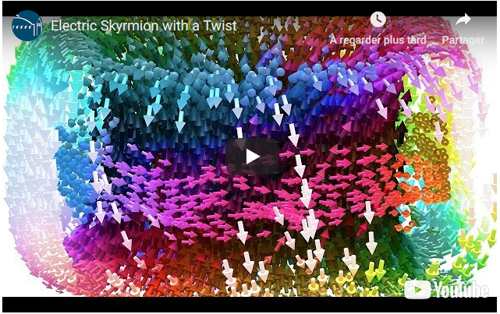
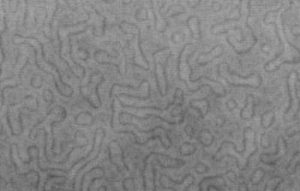
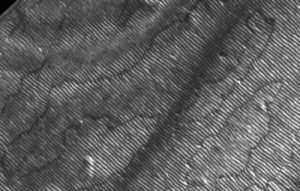
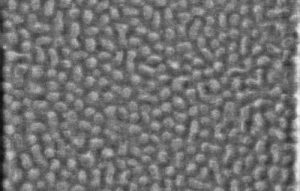
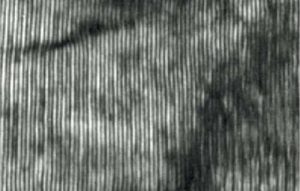
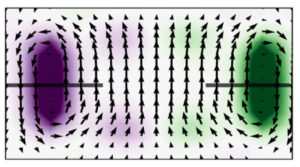
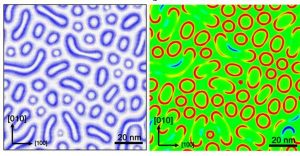
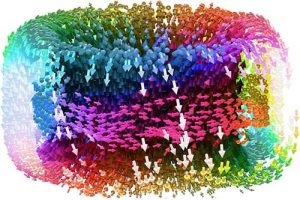





 Subscribe to our free daily newsletter
Subscribe to our free daily newsletter

